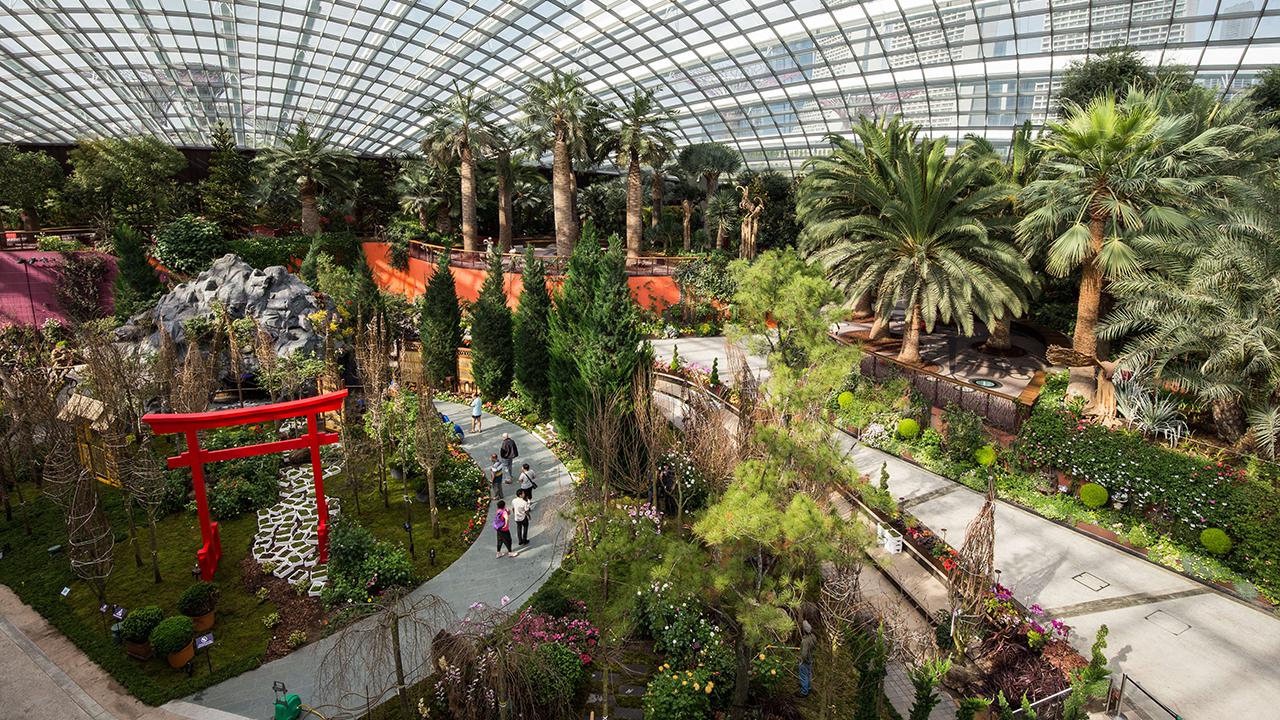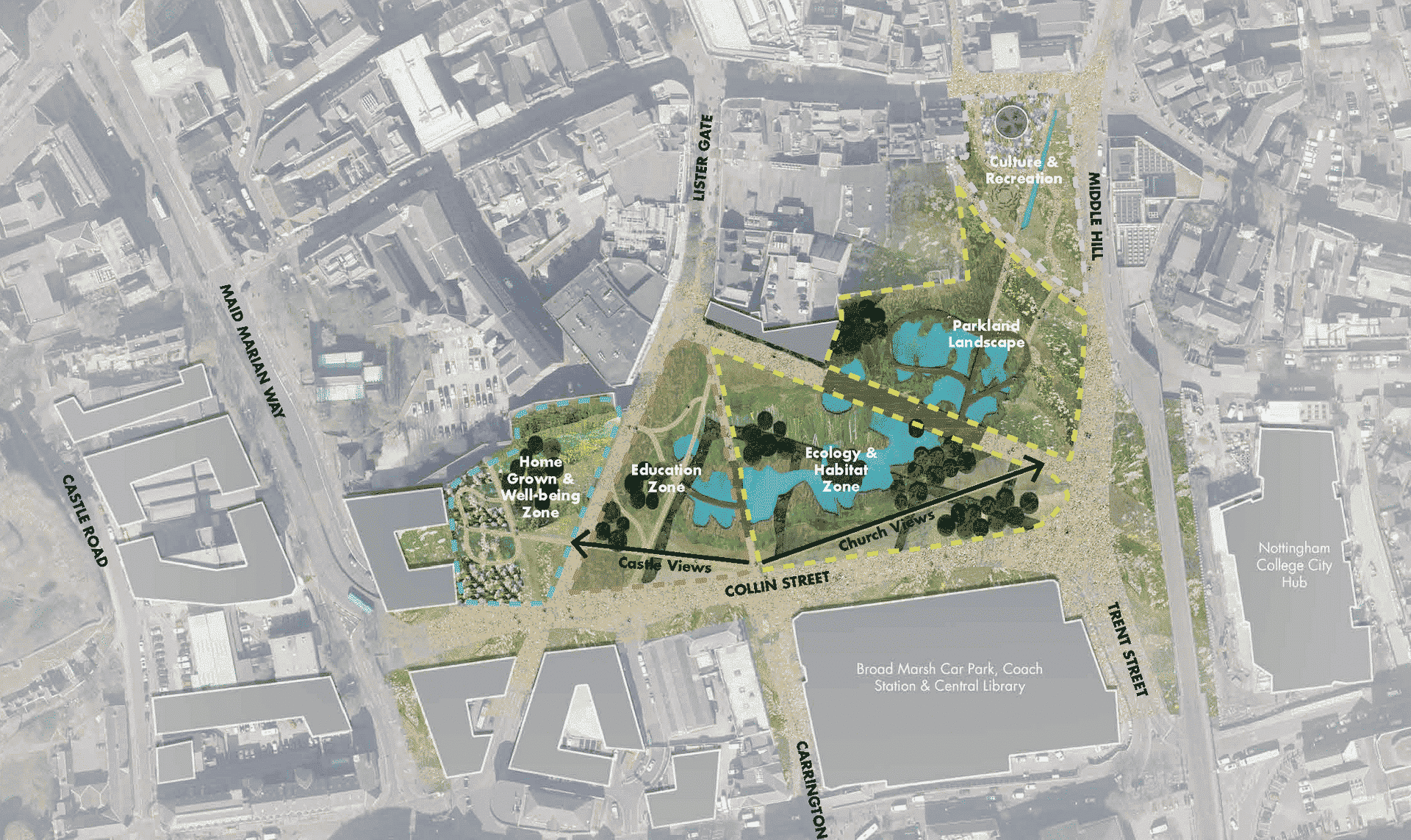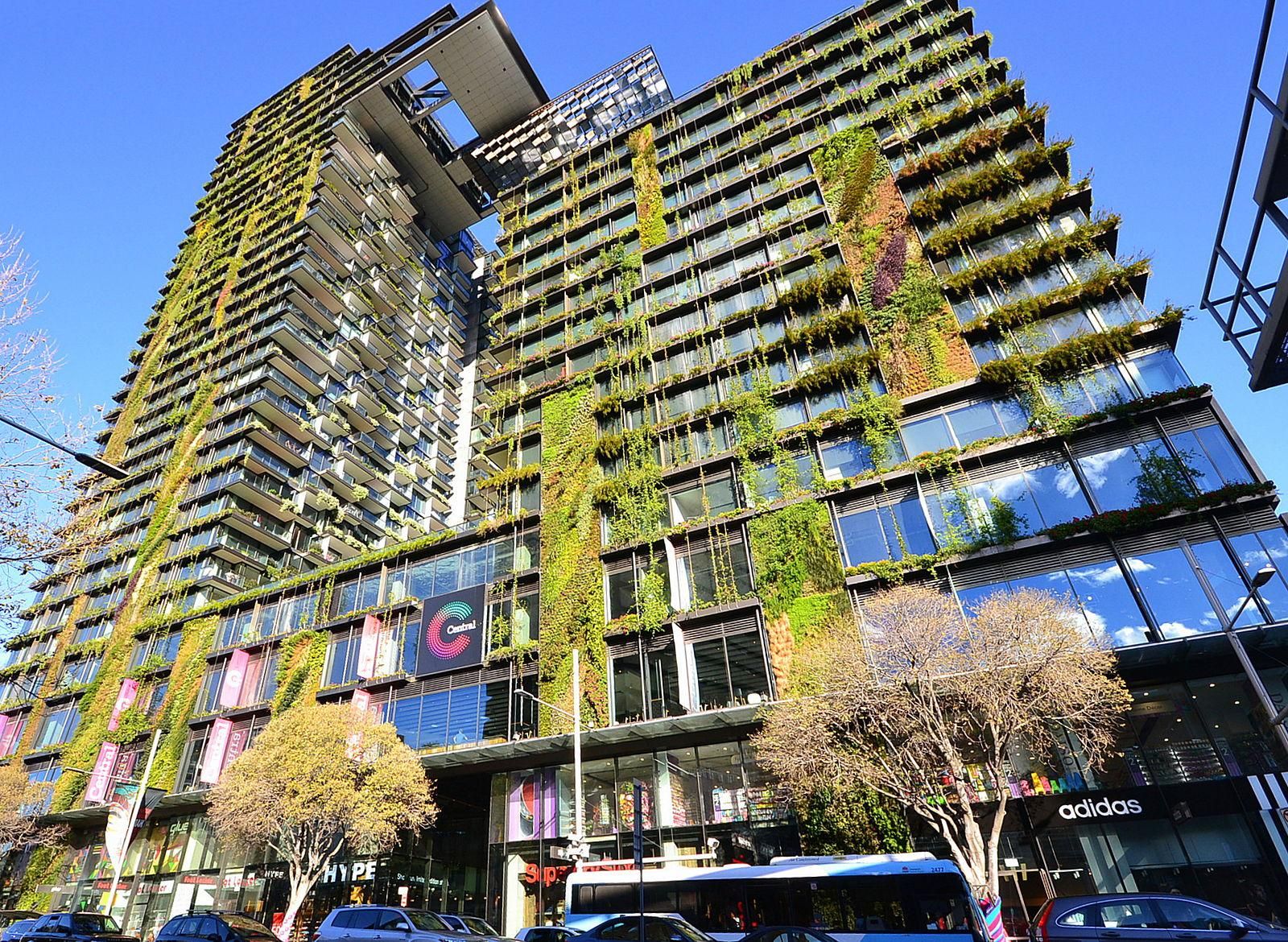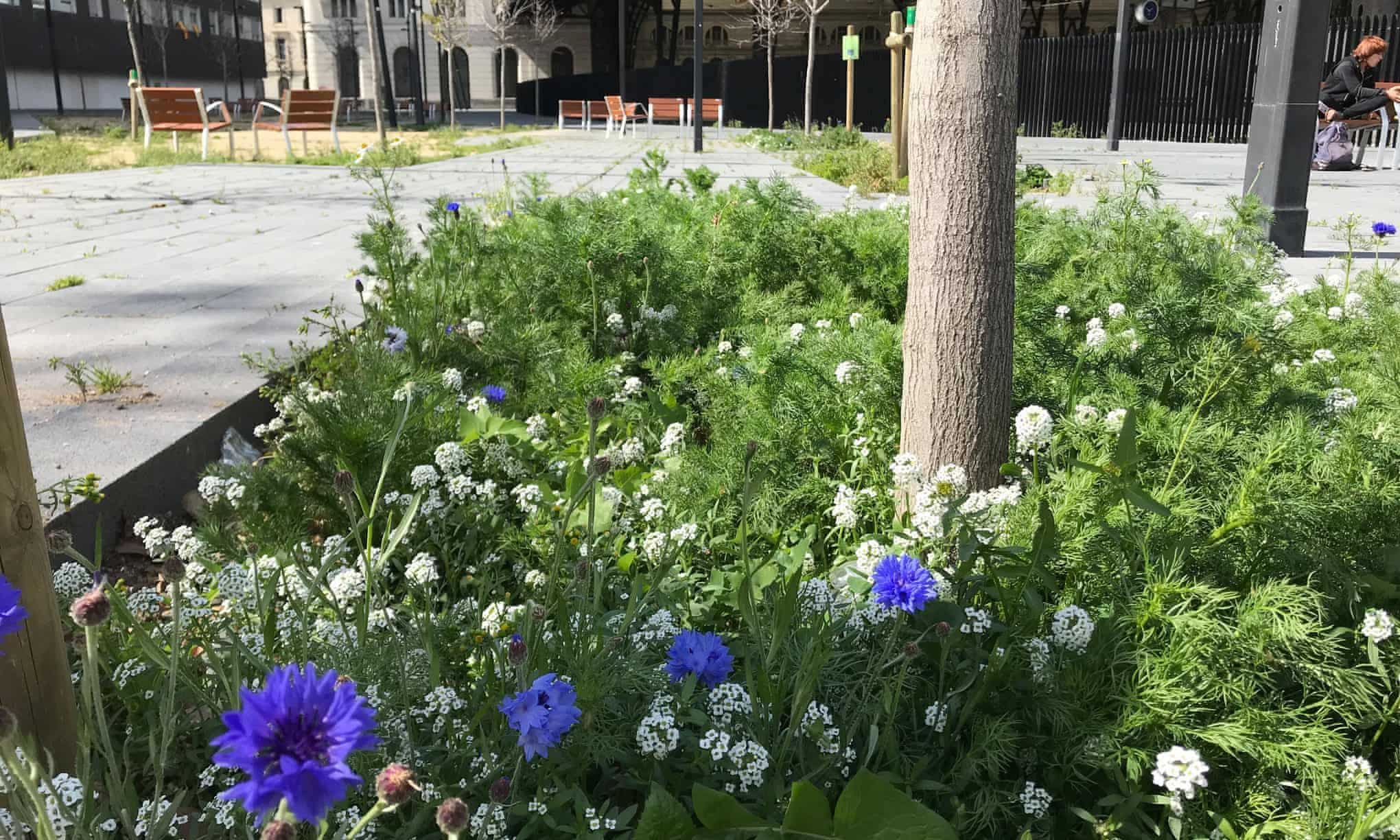

The Singapore Flower Dome is an innovative venue with the largest greenhouse in the world with rotating displays of flowers and plants. John S. Lander / LightRocket / Getty Images
In the midst of a massive, global loss of nature, cities around the world are finding ways to protect and expand open spaces and “rewild” their communities.
Between 2001 and 2017, the United States alone lost 24 million acres of natural area – or the equivalent of nine Grand Canyon national parks – largely due to housing sprawl, agriculture, energy development, and other anthropogenic factors, according to a 2019 Reuters report. Every day, 6,000 acres of open space – parks, forests, farms, grasslands, ranches, streams, and rivers – are converted for other uses.
Rewilding restores an area to its original, uncultivated state, shifting away from the centuries-long practice of controlling and managing nature for human need. It incorporates both the old and the new, allowing wildness to reclaim an area and/or incorporating new elements of architectural or landscape design, like growing greenery on the facades of buildings.
The practice of rewilding is frequently carried out in wild areas; many projects aim to restore biodiversity in an ecosystem, often by reintroducing animal species that are high on the food chain, which in turn stabilizes lower species. One of the most famous cases of rewilding is the reintroduction of wolves to Yellowstone National Park in 1995.
Cities too have begun rewilding; but, although these were spaces were once as wild as Yellowstone, introducing apex predators to New York City or Tokyo might not be the best method for success. Rewilding in urban areas might instead include reintroducing native plant species, building parks on empty lots, incorporating more biophilic design when building new structures, or simply allowing nature to reclaim space. A major draw to rewilding in urban areas is the proven positive impact of nature on human health – particularly for city-dwellers with less access to outdoor spaces.
Here are a few cities that have taken on the task of rewilding.
1. Singapore

Gardens by the Bay, which features the two cooled conservatories “Flower Dome” and “Cloud Forest”, the Supertrees at the Supertree Grove, the Heritage Gardens, The World of Plants, and the Dragonfly and Kingfisher Lakes, on July 29, 2017, in Singapore. studioEAST / Getty Images
In an effort to increase quality of life and restore native vegetation in the city, the Gardens by the Bay have transformed Singapore from a “Garden city” to a “City in a Garden.” 18 “Supertrees” are dispersed throughout the landscape along Marina Bay, some as high as 160 feet; while not living things themselves, the trees are home to over 158,000 plants and mimic the functions of regular trees by providing shade, filtering rainwater, and absorbing heat.
Built on former industrial land, Bishan-Ang Mo Kio Park is also an example of rewilding in Singapore, incorporating elements of water-sensitive urban design and reducing the urban heat island effect in the city. The park is built around the Bishan river, which now flows freely as a natural stream system, unimpeded by man-made barriers. Within the first two years after these rewilding efforts were implemented in the park, biodiversity increased by 30%, even though no wildlife was introduced. Additionally, visitors from the surrounding cities of Bishan Yushin, and Ang Mo Kio are provided a natural respite from city life.
Beyond parks, Singapore maintains more than 90 miles of Nature Ways: canopied corridors that connect green spaces, facilitating the movement of animals and butterflies from one natural area to another throughout the city. These routes mimic the layers of the ecosystem with shrub, understory, canopy, and emergent layers, providing habitats for different species at their various heights.
Singapore has also developed a City Biodiversity Index to examine and track the progress of biodiversity and conservation projects. Thanks in part to these rewilding efforts, Singapore is now considered Asia’s greenest city.
2. Nottingham, United Kingdom

Nottinghamshire Wildlife Trust / Influence
With the number of empty storefronts on UK high streets at the highest level in six years, the Nottinghamshire Wildlife Trust has proposed a new vision for the empty Broadmarsh shopping center in the city: an urban oasis of wetlands, woodlands, and wildflowers.
The proposal was submitted to city council in December, and its proponents hope it will bring back native species and link the city to the nearby Sherwood Forest. The Wildlife Trust cites COVID-19 as a breakthrough in the way people view wildlife and nature, as many rushed to natural areas for solace throughout the pandemic.
Replacing these 6 acres of development – which is widely considered an eyesore by the community – could set a precedent for how such spaces are redeveloped in the future, perhaps reintroducing nature on available land rather than concrete and asphalt.
3. Haerbin, China

The Qunli National Urban Wetland. Turenscape
As climate change promises more frequent natural disasters, many cities are addressing the problem of increased flooding. The city of Haerbin, China – the capital of China’s northernmost province, which sees 60-70% of its annual precipitation from June-August – has taken a creative approach: fostering a wetland in the middle of the city.
In 2009, landscape architects made plans to protect an existing 34-hectare wetland in the center of the city that had been cut off from its water sources by development, proposing that the location be transformed into an urban stormwater park: the Qunli National Urban Wetland.
The park provides invaluable ecosystem services: collecting and filtering stormwater into the aquifer, recovering a native habitat vital to the surrounding ecosystem, and supplying a place for recreation in the city with a network of raised paths and viewing towers for visitors.
4. Dublin, Ireland
One-third of bee populations in Ireland are threatened with extinction, so the country has begun retiring their lawnmowers and letting grasses grow high.
Ireland developed the All-Ireland Pollinator Plan to be implemented between 2015 and 2020, with an updated version outlining the continued plan for 2021-2025. Dublin too created a 2015-2020 Biodiversity Action Plan, aimed at reducing mowing and herbicide use in parks, roadsides, and other green spaces. By letting native plants grow instead of maintaining monocropped, chemical-laden lawns, native insect, bird, and bee populations thrive. Thanks to this initiative headed by the Dublin City Council, 80% of the city’s green spaces are now “pollinator-friendly.”
5. Sydney and Melbourne, Australia

One Central Park in Chippendale. Sardaka / Wikimedia Commons / CC BY 3.0
Australia has caught on to the biophilic cities movement: a different design approach that brings nature and urbanites together, welcomes back native species, and makes even the densest cities more “natureful.”
The government architect of New South Whales outlines the benefits of bringing nature into cities – for human health, improved property values, and resilience against the effects of climate change – by creating more green infrastructure in The “Greener Places” framework, released last year. The biophilic One Central Park in Chippendale – a suburb of Sydney – is known for its vertical hanging gardens, which incorporate 35,200 plants of 383 different species more than 1,120 square meters of the building’s surface. The apartment block also employs a drip irrigation system for the plants, a tri-generation plant for energy, and a cantilever that redirects sunlight into a nearby park at various times of day.
Just down the coast, Melbourne has taken similar action with the Green Our City strategic action plan, which outlines how nature can be brought back into the city through green walls and roofs. Construction is expected to begin next year on the proposed “Green Spine” building on the city’s Southbank, which will become the country’s tallest building, and the world’s tallest vertical garden.
6. Hanover, Frankfurt, and Dessau, Germany
[facebook https://www.facebook.com/staedtewagenwildnis/photos/2602357756705930 expand=1]
As a part of the Städte Wagen Wildnis (“Cities Venturing into Wilderness,” or “Cities Dare Wilderness”) Project, Hanover, Frankfurt, and Dessau, Germany have agreed to set aside plots in cities – such as the sites of former buildings, parks, vacant lots, etc. – where nature will be allowed to take over. The project is largely experimental; the hands-off approach to these green spaces means that minimal intervention will occur by participating cities, and wilderness will be allowed to reclaim the spaces unimpeded.
The resulting wildflower gardens and untamed nature will create new habitats for plant and animal species, and thus will increase the overall biodiversity of these cities. Since the project’s onset in 2016, The Federal Agency for Nature Conservation and the Federal Ministry for the Environment have already reported greater drought tolerance of these areas and increases in the number of butterflies, bees, birds, butterflies, and hedgehogs.
Along with aiding native populations, another major goal of this initiative is to provide more opportunities for recreation and improve the quality of life of nearby citizens with greater exposure to nature.
7. New York City, United States
[instagram https://www.instagram.com/p/CP_rYAlA2Xe/?utm_source=ig_web_copy_link expand=1]
At first glance, the concrete jungle of New York City doesn’t exactly appear particularly hospitable to wilderness. However, the city has become an example of how unused development – no matter how narrow or unlikely – can be transformed into a natural oasis. On the site of a former elevated railroad, the High Line gardens have become a staple attraction of Manhattan with a walkway stretching 1.5 miles through Chelsea along the Hudson River.
The High Line gardeners work to facilitate the natural processes occurring in this landscape, allowing plants to compete, spread out, and grow/change as they would in nature. In an environment as densely populated and developed as New York, the High Line provides a valuable habitat for native butterflies, birds, and insects – and, of course, the hundreds of plant species covering its surface.
8. Barcelona, Spain

Lorena Escuer / Hydrobiology / Handout
When Barcelonans emerged from their homes after the six-week coronavirus-induced lockdown last April, they found that the city was bursting with growth. With parks closed, nature had begun to reclaim spaces, and, after spending weeks indoors, Barcelona’s citizens were eager to experience more nature in the city.
In May and June of 2020, the Urban Butterfly Monitor Scheme found significant increases in biodiversity: 28% more species per park overall, 74% more butterflies, and an explosion of plant growth during the spring rains that supplied more insects for birds to feed on.
Inspired by these changes – having had difficulty pursing rewilding efforts in previous years – the city is now working to create 49,000 square meters of “greened” streets and 783,300 of green open space. Furthermore, beehives and insect hotels have been dispersed throughout the city, as well as 200 bird- and bat-nesting towers to encourage even more biodiversity.
Linnea graduated from Skidmore College in 2019 with a Bachelor’s degree in English and Environmental Studies, and now lives in Brooklyn, New York. Most recently, Linnea worked at Hunger Free America, and has interned with WHYY in Philadelphia, Saratoga Living Magazine, and the Sierra Club in Washington, DC.
Linnea enjoys hiking and spending time outdoors, reading, practicing her German, and volunteering on farms and gardens and for environmental justice efforts in her community. Along with journalism, she is also an essayist and writer of creative nonfiction.
- This Floating Village in Amsterdam Could Help Tackle City-Density ...
- City dwellers gained more access to public spaces during the ...
- Infrastructure for Insects: Congress Should Invest in Bees and Butterflies - EcoWatch
- The Case for Passive Rewilding: 'If You Love It, Let It Free' - EcoWatch

 233k
233k  41k
41k  Subscribe
Subscribe 